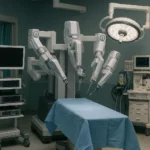Endoscopic Spine Surgery : Fast Relief, Minimal Invasion
Back pain plagues almost everyone at some stage, but long-lasting back pain—over 12 weeks—is enough to seriously interfere with life. Conventional treatments such as therapy, medications or even open surgery are not effective for everyone. Over the past decade, endoscopic spine surgery has transformed spine care. This newer, minimally invasive technique has provided quicker recovery, less complication and outstanding results, particularly for those not responding to traditional treatments.
In this context, this blog explores how this cutting-edge method is transforming lives, contrasted with older treatments, and the science and specialists behind the change.
Understanding Chronic Back Pain
Chronic back pain is more than a nuisance—it can disrupt mobility, mood, sleep and overall quality of life. Unlike acute pain, which usually follows sudden injury or strain and lasts a few days or weeks, chronic pain persists. It may be caused by:
- Degenerative disc disease
- Herniated discs
- Spinal stenosis
- Sciatica or nerve impingement
To begin with, the human backbone is a complicated structure, containing the spinal cord and its network of branching nerves. Moreover, inflammation, compression or injury to the system can cause ongoing transmission of pain signals. For most, lifestyle issues like sitting for extended periods of time, poor posture or inactivity lead to aggravating symptoms.
If the usual pain management treatments such as physiotherapy or medications are not providing relief, the patient is usually referred to pain management physicians or spine surgeons for additional evaluation.
What is Endoscopic Spine Surgery?
To begin with, Endoscopic Spine Surgery (ESS) is a minimally invasive surgical procedure that employs the use of a tiny endoscope, a thin tube with a high-definition camera, and special instruments to address spinal issues. In contrast to open surgery, ESS needs only a small cut, usually no longer than one centimeter.
The surgeon is guided through this tiny opening in order to treat the damaged spot—whether bulging disc, compressed nerve or bone spur. With the help of live video and cutting-edge imaging, the surgeon does precise work with minimal damage to healthy tissues.
There are multiple types of ESS, which include:
- Endoscopic discectomy (herniated disc material removal)
- Endoscopic decompression (pressure relief off nerves)
- Endoscopic rhizotomy (numbing pain messages)
This method is best suited for patients with localised conditions leading to chronic back pain, particularly those who have not responded to non-opioid pain management or conservative treatments.
How Endoscopic Spine Surgery is Performed
To begin with, preparation for ESS starts with extensive diagnostics—MRI, CT scans and neurological tests—to determine the source of pain. Subsequently, after scheduling surgery, patients typically receive mild sedation or local anesthetic.
This is how the procedure generally works:
- A minuscule cut (around 8-10 mm) is performed close to the target site.
- An endoscope is introduced to achieve good internal views.
- Special micro-instruments are introduced to eliminate or fix the damaged structure.
- The area is disinfected, and the wound is closed with a few sutures.
Generally, the procedure takes about 30–90 minutes and the majority of patients leave the same day. As a result, healing is less painful and faster with less muscle and tissue disruption.
Benefits of Endoscopic Spine Surgery
ESS is widely appreciated by both patients and surgeons for its remarkable benefits:
- Minimally Invasive: No major cuts or muscle tearing.
- Outpatient Procedure: Return home the same day.
- Lower Risk: Reduced chances of infection and bleeding.
- Short Recovery: Most patients resume normal activity within 2-4 weeks.
- Cosmetic Advantage: Tiny scar that often fades completely.
- Less Dependency on Painkillers: As the pain is effectively treated at its source, there’s less need for opioids.
It is particularly ideal for those who are hesitant about traditional spine surgery or looking for a faster return to work and life.
Risks and Limitations to Consider
While ESS is usually safe, it is not suitable for all spinal conditions. Patients with severe deformity of the spine, tumor or gross instability will still need conventional surgical procedures.
Possible risks are:
- Inadequate pain relief (very infrequently)
- Nerve irritation
- Bleeding or infection (extremely low risk)
- Return of symptoms necessitating revision surgery
Therefore, selecting the best spine surgeon in India or an experienced endoscopic spine surgeon is important in reducing these risks. In fact, skill and experience are the major factors in determining the outcome.
When to See a Doctor
Back pain can be frustrating, but not all cases require a surgical solution. So, how do you know when it’s time to consult a doctor—particularly a pain management doctor or spine specialist?
Here are signs you should not ignore:
- Pain that persists for more than 6 weeks
- Pain radiating down the leg or arm
- Numbness or tingling in the limbs
- Loss of bladder or bowel control
- Difficulty standing or walking
- Pain disrupting sleep or daily activities
Whereas acute pain can cure itself with rest and attention, chronic pain signs indicate something worse—usually a matter of nerve compression, disc issues or spinal irregularities. Prompt intervention by the proper expert, including consultation with endoscopic spine surgeons, can avert further complications and result in improved outcomes.
Recovery After Endoscopic Spine Surgery
One of the standout features of ESS is its speedy recovery:
- First few days: Mild soreness and fatigue
- Week 1–2: Walking and light activities resume
- Week 3–4: Most patients return to work
- Week 6 onwards: Gradual return to exercise and full movement
Rehabilitation may include physical therapy, posture correction and core strengthening. Patients are also advised to avoid heavy lifting, prolonged sitting and sudden twisting during the healing phase.
Following surgeon advice and engaging in preventive measures ensures long-term relief from chronic pain symptoms.
Future of Spine Surgery: What Lies Ahead
As technology continues to evolve, spine surgery is poised for even more advancements:
- Robotics-assisted ESS for greater precision
- Artificial intelligence in diagnostics and treatment planning
- 3D navigation systems for better targeting
- Personalised treatments based on genetics and biomechanics
These innovations aim to make spine care safer, faster and even more effective—paving the way for non-opioid pain treatment options that combine surgical precision with long-term relief.
What Research Reveals
Over the years, the history of spinal surgery has made tremendous progress. Years ago, open back procedures were the standard—meaning big incisions, long hospitalisation and a high chance of complications. As a result, scientists and surgeons started looking for alternatives that would provide greater accuracy, faster recovery and minimal trauma to the body.
Endoscopic spine surgery emerged as a result of such innovation. Clinical research has consistently shown that patients undergoing ESS experience:
- Less blood loss
- Minimal scarring
- Lower infection risk
- Reduced reliance on opioids post-surgery
One pioneering study in the Journal of Spine Disorders and Techniques found that ESS patients were back to work up to 4 weeks sooner than open surgery patients. With improved visualisation through cameras and micro-instruments, surgeons now reach problem sites in the spinal cord with unprecedented precision—reducing pressure on spinal cord nerves and allowing for faster healing.
The combination of pain modulation methods with real-time imaging continues to improve this method, rendering it safer and more effective than ever.
Why Choose Regimen Healthcare for Your Spine Surgery Journey?
- Global Patient Expertise: We’ve helped thousands from Africa, CIS, GCC, and Asia access trusted healthcare in India.
- Top Specialists: We connect you with the best endoscopic spine surgeon in India, based on your condition and preferences.
- Multilingual Support: Our team speaks your language—ensuring smooth communication from start to finish.
- End-to-End Coordination: From doctor appointments to airport pickups—we manage it all.
- Transparent & Affordable: We offer cost-effective packages with no hidden fees.
Why India is a Global Hub for Endoscopic Spine Surgery
- World-Class Hospitals: Equipped with advanced endoscopy suites, AI tools, and robotic spine systems.
- Skilled Surgeons: Home to the best spine surgeons in India with international training and certifications.
- Affordable Excellence: Receive premium care at a fraction of Western costs.
- Minimal Wait Time: Fast appointments, faster surgeries, and quicker recoveries.
- Medical Tourism Friendly: India welcomes thousands of international patients annually with top hospitality.
Struggling with chronic back pain? If so, want a safe, fast and effective solution without long hospital stays?
Final Thoughts
Endoscopic spine surgery is not merely another procedure—it is a new frontier in the treatment of chronic spinal conditions. For individuals fighting chronic back pain, particularly when other treatments have proven unsuccessful, this method provides an actual opportunity for regaining mobility and a sense of peace of mind.
If you are experiencing chronic back pain, don’t take it lightly. Consult a skilled pain management physician or the top spine surgeon in India to see if you qualify for this minimally invasive procedure.
Indeed, the future of spine treatment has arrived—and it’s changing lives, one endoscopic procedure at a time.
👉 Let Regimen Healthcare guide your journey to pain-free living!
💬 Contact us now to schedule a consultation with the best endoscopic spine surgeons in India.
📞 WhatsApp us at: +91-9310356465
🌐 Visit: www.regimenhealthcare.com
Your healing begins with a single step. Let’s walk it together.
Frequently Asked Questions (FAQs)
1. What is endoscopic spine surgery?
To clarify, it’s a minimally invasive procedure using a small camera and tools to treat spine problems with less pain and faster recovery.
2. Who needs endoscopic spine surgery?
People with chronic back pain from herniated discs or spinal stenosis who haven’t improved with pain management may benefit.
3. Is it painful?
No, it’s done under local or mild anesthesia and causes minimal discomfort. Moreover, it’s ideal for non-opioid pain treatment.
4. How long is the recovery?
Most patients recover in 2–4 weeks and return to daily activities quickly.
5. Are results permanent?
Often yes, especially when done by experienced endoscopic spine surgeons with proper rehab.
6. What are the risks?
Low risk of infection or recurrence. Choosing the best spine surgeon in India reduces complications.
7. Is general anesthesia required?
Usually not. Many procedures use local anesthesia for faster recovery.
8. How does it help with pain?
It relieves pressure on spinal cord nerves, improving natural pain modulation.







